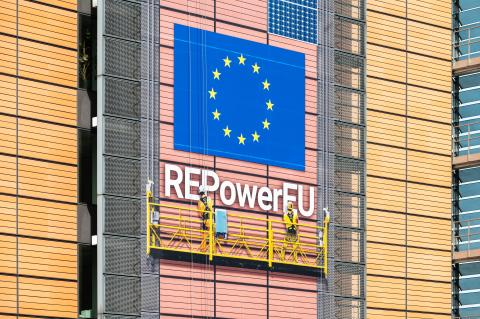EU Gas Flows Tracker
Last updated: September 2025
About
IEEFA’s EU Gas Flows Tracker is an interactive data tool to visualise Europe’s gas pipeline flows. It is built by compiling data from Eurostat, the EU Joint Research Centre’s security of gas supply dashboard and IEEFA analysis.
Note: Using an updated internet browser will help to ensure all graphics on this page display correctly. Some elements might not appear properly on all mobile devices. For any issues, contact us.
Subscribe to receive all the latest updates
Key Findings
- EU pipeline gas imports* declined by 9% year on year in the first half of 2025, as Russian gas transit via Ukraine ended on 1 January. The bloc increased its reliance on LNG and benefited from ongoing measures to curb gas demand.
EU countries must accelerate renewable energy and heat pump installations to boost their energy security and protect consumers from volatile gas prices.
Since the beginning of 2022, EU countries have spent about €380 billion on pipeline gas imports.
EU imports of Russian pipeline gas via Türkiye have risen in recent years.
*"Imports" refer to gas and LNG received in the EU from a country outside the bloc.
Data policy
This page provides data from publicly available datasets provided on the EU security of gas supply dashboard of the Joint Research Centre (JRC) of the European Commission. The JRC states that the “data published in the dashboard is sourced exclusively from public information.” Any use (including distribution or publication) of the data should properly attribute the source, “Eurostat, JRC EU security of supply dashboard, IEEFA analysis,” but not in any way that suggests that IEEFA endorses the user their use of the data.
Replacing gas consumption, not increasing imports, can boost energy security
Faced with energy security risks in 2022, the EU responded by diversifying energy sources and reducing gas consumption. Renewables generation, energy efficiency and demand-side management programmes have helped the bloc cut gas use. EU countries reduced their gas consumption by 20% between 2021 and 2024, leading to an 18% decline in their combined imports of gas and liquified natural gas (LNG) during that period.
The end of Russian gas transit via Ukraine on 1 January 2025 – totalling about 15 billion cubic metres (bcm) in 2024 – contributed to a 9% year-on-year decrease in EU gas pipeline imports in the first half (H1) of 2025 and a 21% increase in LNG imports. However, the bloc’s combined gas and LNG imports in that period grew by only 3.4% compared to H1 2024 and fell by 0.6% compared to H1 2023.
Gas pipeline imports accounted for 52% of total EU gas imports in H1 2025, dropping from 77% in H1 2021.
EU gas use expected to resume downward trend from 2026
EU gas consumption in H1 2025 increased by 4% year on year, but it was still 21% less than in H1 2021. Despite the rise in 2025, IEEFA expects EU gas consumption to continue declining in the coming years. A recent European Commission communication on the REPowerEU Roadmap said: “The full implementation of the energy transition and the recent Action Plan for Affordable Energy are expected to replace up to 100 bcm of natural gas by 2030.” If these efforts continue, falling consumption could reduce the EU’s combined gas and LNG imports by 25% between 2024 and 2030.
Weather and lower renewable generation have influenced the rise in gas use in 2025. Low temperatures in the first three months of 2025 drove a 15% increase in EU gas consumption compared to the previous quarter. According to Eurostat, 42.5% of net electricity generated in the EU came from renewable energy sources in the first quarter of 2025, down from 46.8% in the same period of 2024. Although solar power generation grew, it was not enough to compensate for the loss of hydro and wind production.
The small increase in EU gas consumption in H1 2025 highlights that EU countries must do more to lower their gas demand and reduce their dependency on imports of the fuel. This would lessen their exposure to potential gas supply disruptions caused by geopolitical issues.
To shield against any potential energy crisis that could arise and protect consumers from volatile gas prices, EU countries must also scale up wind, solar and heat pump deployment. Current installation rates are falling short of what the EU requires to meet its targets.
Gas pipeline imports by source
Norway is the EU’s main source of pipeline gas, representing 55% of the import mix in H1 2025, followed by Algeria (19%).
The EU plans to gradually stop the import of Russian gas and oil by the end of 2027. Nonetheless, annual EU imports of Russian pipeline gas via Türkiye have been gradually increasing in recent years.
Meanwhile, Lithuania continues to allow the transit of Russian pipeline gas through its territory to Russia’s Kaliningrad exclave. This long-term transit contract with Gazprom is set to expire in December 2025.
In H1 2025, EU gas pipeline imports from Azerbaijan, Libya and Norway decreased year on year, while those from Algeria, Russia via Türkiye, Türkiye and the UK slightly increased.
Main changes in internal flows
After Russian gas transit via Ukraine stopped in January 2025, some European internal gas flows changed direction.
There was a notable shift for Slovakia, which went from receiving gas from Russia (via Ukraine) and Hungary in H1 2024 to sending gas to Ukraine in H1 2025.
Gas flows from Belgium to the Netherlands and Germany increased by around 60% year on year in H1 2025.
Although EU gas pipeline imports have decreased in 2025 due to the end Russian gas transit via Ukraine, the change in some gas flows shows how the bloc can guarantee security of supply with its existing gas infrastructure.
EU spending on pipeline gas imports
Since the beginning of 2022, EU countries have spent around €381 billion on pipeline gas imports. Of this amount, around €176 billion was from Norway, €83 billion from Russia, €49 billion from Algeria, €40 billion from the UK, €29 billion from Azerbaijan and €5 billion from Libya.
> Receive our updates and analysis on the EU Gas Flows Tracker:

